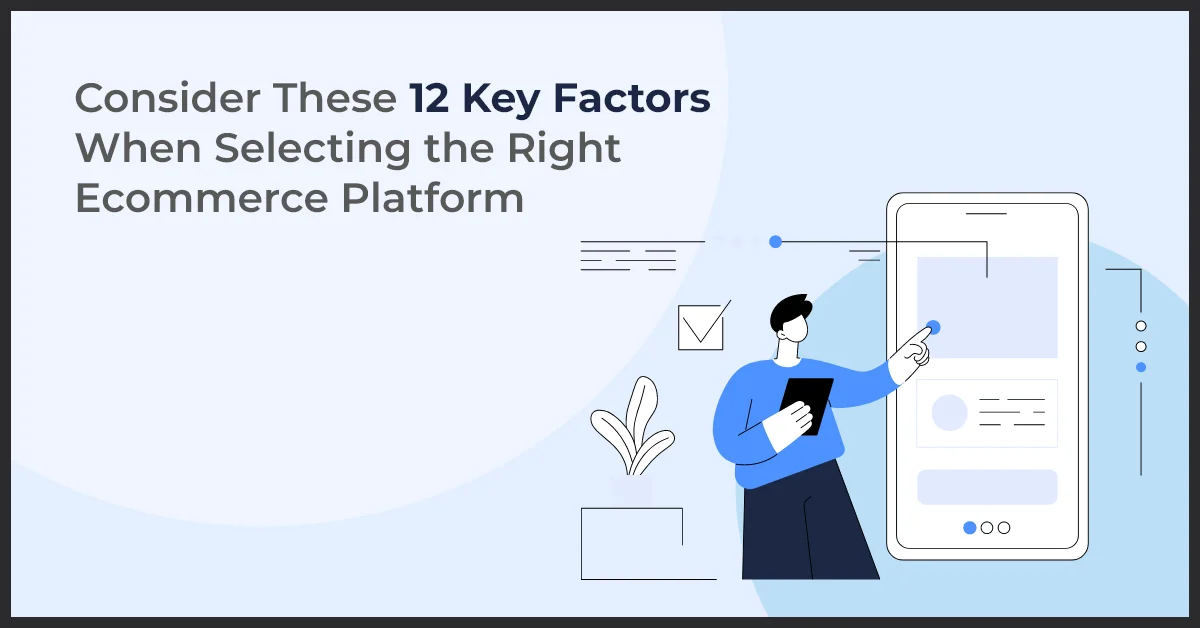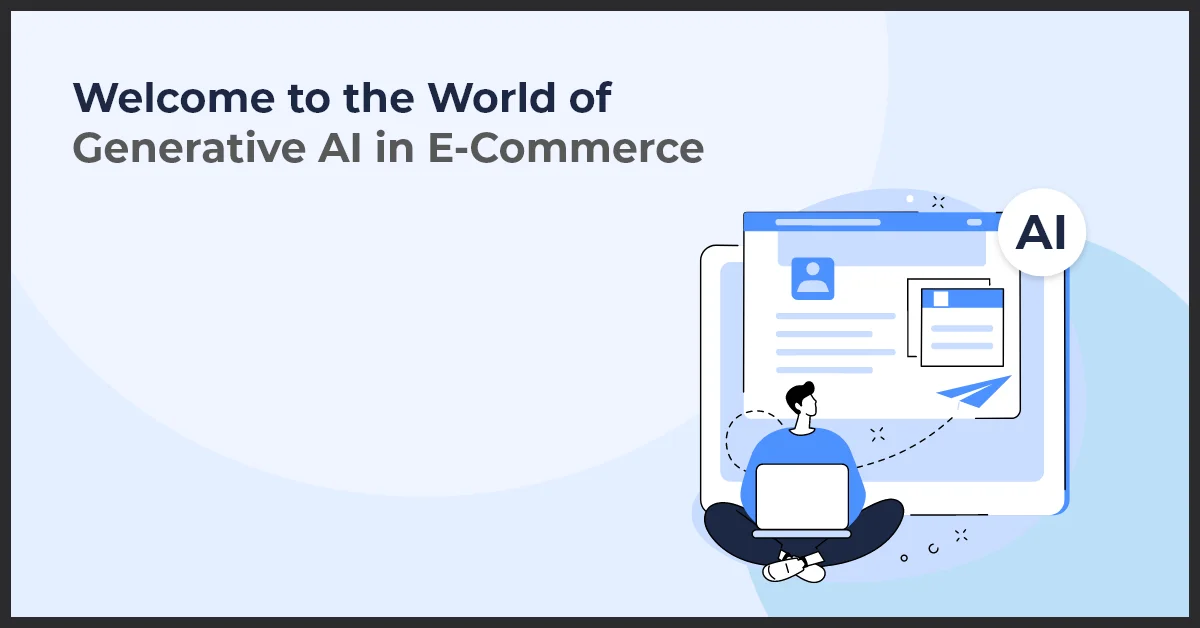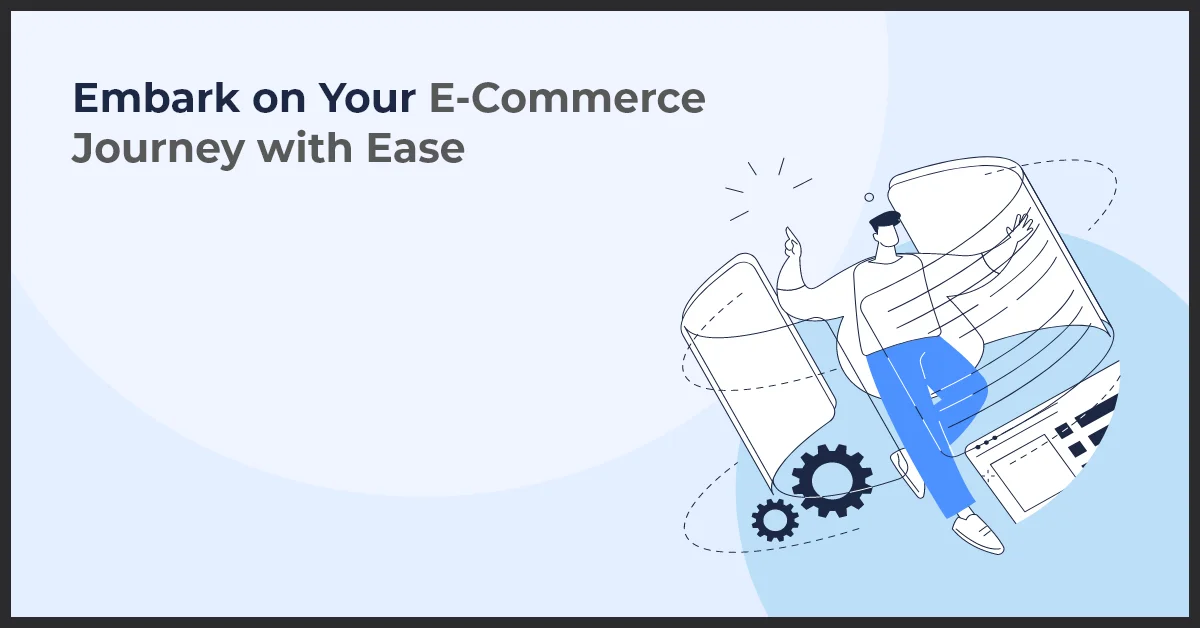Key Factors to Consider When Selecting the Best Ecommerce Platform

Published on: October 8, 2022
Updated on: February 28, 2025
2676 Views
- Ecommerce
10 min read
Ecommerce is a billion-dollar industry in the US alone. Global retail eCommerce sales are estimated to reach $8.1 trillion by 2026. So, if you want to stay ahead in this thriving market, you need to start making some smart investments to upgrade your eCommerce platform.
The right eCommerce platform can help your business thrive but choosing one can be a challenging procedure. Thus, to help you make a sound decision, we have added everything you need to know.
How to Choose the Right Ecommerce Platform?
Selecting the right eCommerce platform is crucial for business success. Consider factors like scalability, customization options, payment integrations, SEO capabilities, and security features. Assess your business needs, budget, and long-term goals before making a decision. Understanding how to choose an eCommerce platform ensures you invest in a solution that supports growth and enhances user experience.
Let’s dive in!
Why Is It Important to Choose the Right Ecommerce Platform
It takes more than just posting your products online to build an eCommerce business. Building a business demands the same amount of strategic planning and thought as managing a physical store or manufacturing plant.
Remember that your eCommerce platform will determine growth, operating expenses, customer engagement, and company objectives when choosing an eCommerce platform.
Moreover, the lead generation process, consumer engagement, and business process are where the true eCommerce challenges are discovered. You could use any of these procedures to check whether your e-commerce platform is generating a reasonable return on investment.
The use of a single platform enables merchants to control virtual assets, online sales, and marketing. It is virtually impossible to compete online if you do not have an eCommerce platform.
Whether it's a B2B or B2C business, the foundation of an online retail operation is an eCommerce platform. A proper eCommerce platform streamlines the interaction between your company's clients, consumers, and workforce.
Now that you understand why choosing the right eCommerce platform is important, let us take you through the essential factors that will help in your research.
12 Factors for Selecting the Right E-commerce Platform for Your Business
1. Understand Your Needs
Before you even begin researching eCommerce platforms, determine what you need. It will be much simpler to identify and pick a solution if you establish your prerequisites in advance. Make a search strategy ahead of time. Outline the current state of your company and your desired future for it.
What services and activities does your website currently provide? The mapping of your consumers' paths to purchases is another excellent technique. What makes them discover you? Which social channels do they use? What method do they prefer for order fulfillment?
Make a list of everything you need. Consider your business's long-term goals. You need a solution that will let your company expand and flourish.
2. Prepare a Budget
Consider how much you're prepared to invest in your e-commerce platform. When establishing your budget, consider the "unanticipated costs" associated with installing a new solution.
Consider fees for maintenance, advice, set up, and additional expenses in addition to the obvious ones like licenses and production. The following are some considerations for your budget:
- Ecommerce platform costs
- Design and development costs
- Maintenance charges
- Transaction and hosting costs
- Consultation fees
There will almost always be a monthly charge for platforms. When making decisions, you must take both the up-front and reoccurring expenses into account. Don't forgo essential items in exchange for a cheaper price.
3. Choose a Secure Platform
If customers are unsure that their added information is safe, especially financial, they won't purchase anything from your eCommerce site. Because of this, every platform you use has to include vital security components such as PCI (Payment Card Industry) compliance, an SSL (Secure Sockets Layer) certificate, and theft protection.
In order to find possible security concerns, the platform should also conduct security audits. So that the required alterations may be made to safeguard clients from hazards. It is essential to select a platform with embedded security procedures, such as two-factor authentication.
Security plugins can offer extra security to platforms that don't have multi-factor authentication for the protection of sensitive information.
4. Ensure You Have the Right Integrations
To meet your company goals and give your consumers the greatest buying experience possible, the eCommerce platform must have the proper integrations. For your e-commerce website's functioning, having those essential integrations can simplify your life.
When it comes to delivering your products, bookkeeping and invoicing, emailing and marketing, auto-filling your website, and many other tasks, integrations are crucial. Not all systems support every integration, so make sure you comprehend your business needs before evaluating the features and functions. The most popular eCommerce plugins are:
- Accounting
- Email Marketing
- Pricing
- Customer Loyalty Programs
- Payment and Shipping
- 3rd Party Digital Tools like CRM, ERP, etc.
5. Get a Responsive Website Design
Ecommerce businesses will have to handle distinct marketing campaigns, advertising, product information, etc. if they choose to have separate desktop and mobile websites. It will increase expenses and consume several resources. This makes responsive website design a must.
With responsive web design, a site automatically adapts to different screen sizes of computers, laptops, smartphones, and tablets. Therefore, responsive web design enables you to provide consumers with a wonderful experience regardless of the device used.
The platforms for developing vertically stacked websites include several responsive themes and templates. Platforms like Magento, WooCommerce, and Shopify are a great way to start. Furthermore, users can alter the colors, sizes, and positions of any element.
6. Opt for Multiple Payment Gateways
There is no one way of making a transaction, which is why companies should always opt for multiple payment options. Plus, this calls for a connection between your business and a secure payment gateway that securely transfers money from your customers' bank accounts into their own.
Although it might seem obvious, not all eCommerce systems are compatible with all payment gateways. Geographical considerations are vital; positioning the payment procedure is important.
Though eWallets are a terrific payment alternative, they still haven't taken over the market. Therefore, be sure that the platform you select offers you a sufficient range of payment methods to appease your core clientele.
7. Make Your Website SEO-Friendly
Customers will only visit your website if they can find it in search results when looking for items similar to the ones you sell. Search Engine Optimization (SEO) is necessary to increase your site's visibility and search engine ranking.
Building organic SEO takes time. To make it easy, you need to choose the platform with best practices in mind and prioritize staying up to date with Google's algorithm updates. In terms of SEO, not every eCommerce platform is created equally.
You must verify what SEO features are offered like basic functions like updating picture captions and metadata, adding a blog and images to their website, enabling customer reviews, and support for Google site maps, and many more.
8. Check Platform Scalability
You are here to expand your eCommerce business. So, select a platform that can grow with your company. Additionally, the platform shouldn't demand outrageous prices for adding extra functionality and storage to accommodate your growing business needs.
Look for a scalable, cloud-hosted system with features and functions that meet your expanding business's demands right now. It's also important to take into account things like efficient caching techniques and the capacity to automatically delete content when descriptions need to be updated.
Make sure your customers get adequate technical and customer support as well.
9. Ensure Ease of Use and Maintenance
Ease of maintenance and use are two essential things to consider when it comes to selecting a good eCommerce platform. If you are an entrepreneur or new in the B2B marketplace that is something you should take into account. Fortunately, the majority of popular eCommerce systems are user-friendly.
On most platforms, setting up a store is not too difficult. Many systems, especially cloud-based ones, have templates that are simple to change. The degree of personalization you seek is where you can run into problems.
Web hosting is another issue that a cloud-based eCommerce system would take care of. So, if you choose a self-hosted platform, you need to collaborate with a developer for setup and regular maintenance.
10. Choose from Multiple Website Themes
Your eCommerce store's design is determined by its theme. The majority of eCommerce platforms provide a broad collection of themes. Some themes are free, while others are premium. But these premium themes will frequently distinguish your website from competitors and provide your visitors with a unique purchasing experience.
Look for a suitable theme for your eCommerce website, and be sure to pick one with neutral colors. Also, take into account the level of customization you want to add to your website.
Platforms differ in how much versatility they provide. Designing a website that accurately represents your brand may need a bit more work but it all comes worth it in the end.
11. Look for Data Analytics
Revenue and return is the ultimate goal. Regularly reviewing the business performance can help you identify the finest strategies to use to turn a profit. The opportunity to view analytics is available on several e-commerce platforms. This will make it easier to understand how your company is performing.
You can gather data from your website and analyze statistics to better understand any shifts in consumer behavior. Data analytics help in creating strategies to boost sales and generate profit.
Thus, when selections are based on genuine data, you ought to make wise company decisions.
12. Offer Customer Service
Lastly, the key to any business is customer service. Unwanted occurrences like software failures, server outages, and server breakdowns can prevent clients from accessing your website and making transactions at any moment. These not only result in monetary losses but also affect your brand's reputation.
You need swift technical help from your eCommerce platform to get out of such problems quickly and get your business operating normally once again. Because of this, you want to select a platform that offers help just when you need it.
Ask these questions to support staff before choosing a platform. Is technical help offered round-the-clock or only during certain hours? Is the technical team available through phone, chat, self-service, etc.? What are service level costs available?
Key Takeaways
- Choosing the Right Ecommerce Platform: When deciding how to choose an ecommerce platform, consider integrating generative AI to enhance customer experiences through personalized product recommendations and automated content creation, leading to increased customer satisfaction and higher conversion rates.
- Personalized Shopping Experiences: Generative AI transforms ecommerce by offering tailored product suggestions based on customer data, improving engagement and driving repeat purchases.
- AI-Driven Content Creation: Leverage generative AI to automate marketing campaigns and product descriptions, ensuring SEO optimization and compelling narratives that resonate with target audiences.
- Visual Customization and Engagement: Implement AI-powered visual configurators to enhance user interaction, allowing customers to personalize products in real-time, which can lead to increased conversions and brand loyalty.
- Future of Ecommerce: As generative AI evolves, it will play a central role in strategic decision-making, offering insights into consumer behavior and market trends, thereby revolutionizing the ecommerce landscape.
Conclusion
Now you must have a good understanding of what each factor has to offer. All that remains is to evaluate each platform to understand which is the perfect fit for your company. Refer to the above points to make a sound decision.
Still in doubt? Our experts at Growth Natives can help you in making the right decision. Reach out to us at info@growthnatives.com to ensure the best eCommerce platform!
Frequently Asked Questions
Choosing the right e-commerce platform is crucial as it directly impacts user experience, scalability, payment processing, SEO capabilities, and overall business operations. Failure to select the right platform can lead to poor sales, customer dissatisfaction, and hindered business growth.
Key factors include scalability, customization options, integration capabilities (with payment gateways CRM systems), SEO features, mobile responsiveness, security measures, customer support quality, and total cost of ownership.
When selecting an e-commerce platform, consider your business size, product range, growth plans, technical expertise, budget, desired features (like inventory management analytics), and compatibility with existing systems. These specifics will guide your evaluation through trials, demos, and customer reviews.
Choose based on scalability, customization, integration options, SEO capabilities, mobile-friendliness, security, support quality, and total cost. Evaluate platforms through trials, demos, and user feedback to ensure they meet your specific business needs.



